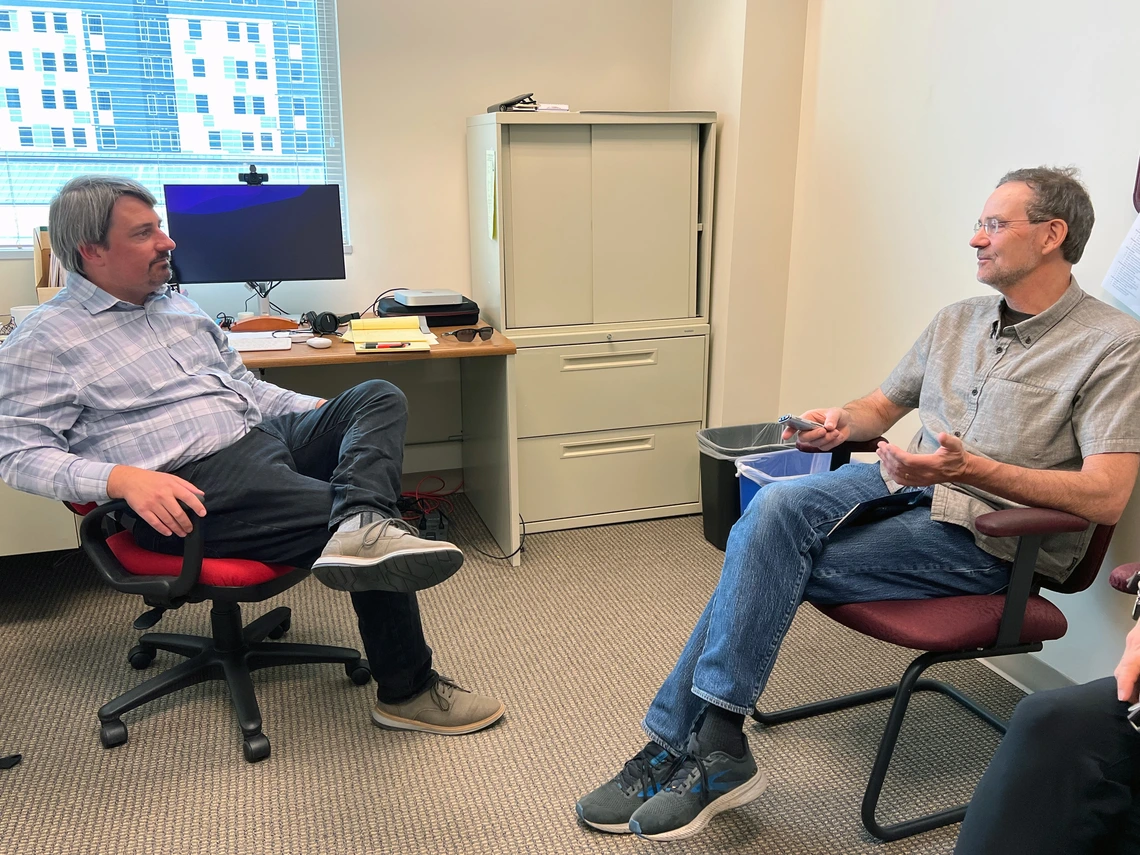Keeping Local Journalism Alive

Richard Watts, director of the Center for Community News interviews Professor Pat McMichael for a Knight Foundation funded project on Wednesday, March 15.
Alexandra Pere
On Wednesday, March 15, the School of Journalism hosted Richard Watts, director of the Center for Community News at the University of Vermont.
Watts interviewed Undergraduate Director Pate McMichael about the opportunities the UArizona School of Journalism provides for students to report outside of the classroom setting.
“I see what we are doing as partnering with local news to give our students a real experience, not a simulated one,” McMichael said to Watts.
Watts was impressed with the apprenticeship class, a course that allows journalism students to work with the award-winning local newspaper, Arizona Daily Star. Students report alongside professional journalists, receive three credits towards their degree and get work published throughout the semester.
“The idea of working so closely with a newsroom, giving students real world experience and contributing to local news is noteworthy,” Watts said.
Watts has traveled across the United States to document other student reporting programs that contribute to local news coverage. View some of the case studies here. Watts remarked during the interview that few schools in the nation had an apprenticeship program like the Journalism School’s.
“I have traveled the country documenting these programs and the commitment of Professor McMichael and your Director Jessica Retis is clear – benefitting students while addressing the crisis in local news,” Watts said.
The apprenticeship course provides students with newsroom experience under the guidance of industry professionals and university professors. Along with the apprenticeship, students can get their work published in the Daily Star and The Arizona Daily Wildcat through our El Independiente course (El Inde).
Cathalena (Cathy) Burch, a music and features reporter for the Arizona Daily Star, teaches the El Inde class as an adjunct professor. Burch reimagined what the El Inde class could offer students by building a stronger relationship with The Daily Wildcat, the University of Arizona's student newspaper.
“My whole intention when I reimagined El Inde Arizona in the Spring 2022 was to give students an outlet to get their work published,” Burch said. “There are so many students who haven't got the time or flexibility to work at The Daily Wildcat or do an apprenticeship and get published clips.”
Under Burch’s direction, Student work could be published through The Daily Wildcat in addition to having their clips live on the El Inde website. Now, Burch has spearheaded a stronger relationship between El Inde students and the Star.
“El Inde Arizona brings to the table stories that the Star often misses with staff shortages and beat rearrangements,” Burch said.
El Inde supports the Star with extra content and students get the adrenaline rush of having their work published in an award-winning newspaper, a symbiotic relationship in the local Tucson journalism community.
Newsrooms across the country have been shrinking over the last decade, but it accelerated during the pandemic. Gannet’s layoffs hit headlines earlier this year and NPR recently laid off several employees and shutdown the publication of several podcasts.
In addition, rising accounts of news deserts across America show that local newspapers have had difficulty transitioning to a digital-era business model. The term news desert could be traced back to 2011, when journalist Laura S. Washington wrote about it as a "communications desert." Generally, a news desert is a rural or urban community that has little or no access to good quality local news and information.
The School of Journalism’s collaborations with local news media strives to stop this from happening in Tucson.
“It is a triple win in that students benefit, the community benefits and the university meet its public service mission,” Watts said.
Watts’ students at the University of Vermont do similar work for the Center for Community News. The Community News Service is a student reporting program where students write stories for local papers, get credit, mentorship with a professional editor and the stories are freely available to any news outlet in the state. Check out their work here.
“My hope is that after the success we have had over the past three semesters, El Inde will continue as a news service, possibly expanding our reach to include publications in Green Valley and Sierra Vista,” Burch said.
Burch’s El Inde students have published nearly 100 stories in the Daily Wildcat and close to 20 in the Star. Read their Daily Wildcat stories here. Read their Star coverage here.

